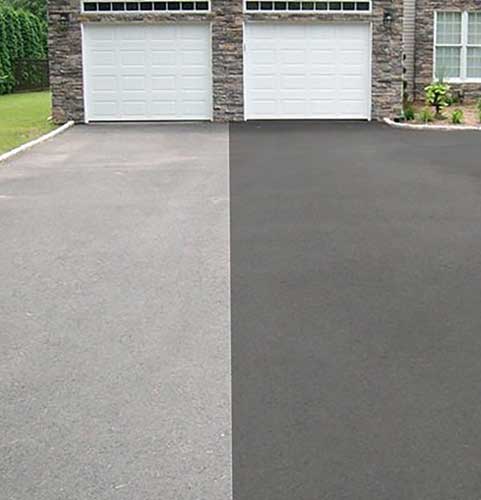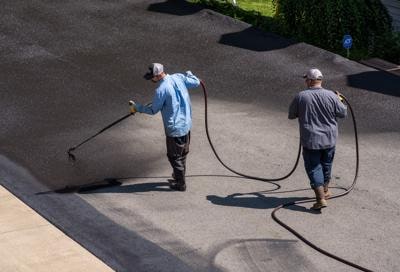Warm Mix Asphalt: A Sustainable Option for Sidewalk
Hot Mix Asphalt (HMA) has actually emerged as a leading sustainable choice for pavement services, supplying a myriad of ecological benefits and innovative innovations. Its capacity to reuse materials and decrease energy consumption presents an engaging case for its adoption in road construction tasks. The long-term efficiency and durability of HMA make it a favored choice for facilities advancement. As the demand for environmentally friendly construction techniques grows, discovering the subtleties of HMA's sustainability can offer important understandings into the future of sidewalk services.
Ecological Benefits of Hot Mix Asphalt

Additionally, Hot Mix Asphalt assists to reduce metropolitan heat island results. Its dark color absorbs sunlight, minimizing the amount of warm reflected back right into the atmosphere contrasted to lighter-colored sidewalks. This can lower ambient temperature levels in city locations, decreasing the demand for cooling and eventually lowering energy consumption.
In enhancement, Warm Mix Asphalt adds to boosted stormwater monitoring. Its porous nature permits water to recharge and infiltrate the sidewalk groundwater supplies, reducing overflow and the danger of flooding. These ecological advantages make Warm Mix Asphalt a sustainable option for leading roadways and highways.
Power Effectiveness in HMA Production
Is power efficiency an important factor in the manufacturing of Hot Mix Asphalt (HMA)? Definitely. Energy plays a considerable function in the production of HMA, affecting both cost and ecological sustainability. One key facet of power efficiency in HMA manufacturing is using warm mix asphalt (WMA) modern technologies (regrading). WMA enables for the mixing and positioning of asphalt at reduced temperature levels compared to conventional hot mix asphalt, causing minimized power intake during production. This procedure not only decreases gas usage but likewise decreases greenhouse gas discharges, making it a much more eco-friendly option.
Additionally, improvements in plant technologies have led to even more energy-efficient HMA manufacturing procedures. By optimizing power usage in HMA production, the market can minimize its carbon footprint while maintaining premium sidewalk products.
Recyclability of Hot Mix Asphalt
The recyclability of Warm Mix Asphalt (HMA) is a crucial facet of its sustainability and lasting environmental effect. HMA is among one of the most recycled products in the United States, with over 100 million lots of reclaimed asphalt pavement (RAP) being recycled annually in new sidewalk building and construction. Reusing HMA supplies numerous ecological advantages, such as decreasing the need for virgin products, lowering power intake throughout manufacturing, and reducing the quantity of waste sent to land fills.
The process of reusing HMA includes milling the existing pavement, crushing it right into smaller items, and blending it with brand-new aggregate and asphalt binder to develop a recycled mix. Generally, the recyclability of HMA plays a significant duty in advertising sustainable techniques within the pavement market.

Long-Term Efficiency of HMA
Asphalt sidewalks show resilience and durability over a prolonged period, reflecting the long-term performance of Warm Mix Asphalt (HMA) The longevity of HMA can be credited to its ability to endure heavy traffic loads, rough weather condition conditions, and the impacts of aging. Research studies have revealed that well-designed and properly built HMA pavements can last for twenty years or even more with routine maintenance. The trick to making best use of the long-term performance of HMA commercial parking lot paving exists in utilizing top quality materials, following best methods in building and construction, and executing reliable maintenance methods. Correct water drainage, routine inspections, and prompt repair services are essential for protecting the architectural integrity of HMA sidewalks over time. Additionally, improvements in HMA technology, such as the use of polymer-modified binders and cozy mix asphalt, have additionally enhanced the longevity and durability of HMA sidewalks. By prioritizing high quality building and construction and maintenance practices, HMA continues to show itself as a sustainable and affordable remedy for long-lasting pavement infrastructure.

HMA: Sturdiness and Sustainability
Demonstrating both toughness and sustainability, Warm Mix Asphalt (HMA) has come to be a cornerstone in the building of durable pavement facilities - commercial parking lot paving. HMA's resilience comes from its capacity to stand up to hefty loads, harsh climate condition, and high website traffic quantities, making it a trusted choice for roads, freeways, and airport terminal paths. The composition of HMA, which usually includes aggregates, binder, and filler, plays a vital duty in improving its longevity and resistance to tear and put on
Furthermore, HMA's sustainability depends on its recyclability and energy-efficient production process. The capability to recycle reclaimed asphalt pavement (RAP) in new HMA blends lowers the demand for virgin materials and reduces the ecological influence of sidewalk construction and maintenance. Furthermore, the power performance of generating HMA depends on its lower mixing temperatures compared to other pavement materials, causing lowered power consumption and greenhouse gas discharges.
Conclusion
To conclude, warm mix asphalt (HMA) offers a sustainable option for pavement with its environmentally friendly attributes. HMA's recyclability, energy efficiency in production, and long-term toughness make it an eco-friendly choice for roadway building and construction. By saving natural deposits, reducing waste, and lowering greenhouse gas exhausts, HMA plays a crucial duty in promoting sustainability in infrastructure development. Its capability to mitigate city warm island impacts even more emphasizes its value in producing resistant and ecologically conscious sidewalk systems.
HMA is one of the most recycled products in the United States, with over 100 million lots of recovered asphalt pavement (RAP) being recycled each year in new pavement building and construction.The process of reusing HMA entails milling the existing sidewalk, crushing it right into smaller pieces, and blending it with brand-new accumulation and asphalt binder to produce a recycled mix.Asphalt sidewalks demonstrate resilience and durability over a prolonged period, mirroring the lasting performance of Warm Mix Asphalt (HMA) Additionally, developments in HMA modern technology, such as the usage of polymer-modified binders and cozy mix asphalt, have additionally enhanced the longevity and longevity of HMA pavements. The capability to reuse redeemed asphalt pavement (RAP) in new HMA blends lowers the demand for virgin materials and reduces the ecological influence of pavement building and upkeep.